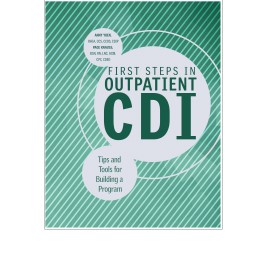Book excerpt: Documenting in the outpatient setting

Tips and Tools for Building a Program
By Anny Yuen, RHIA, CCS, CCDS, CDIP, and Page Knauss, BSN, RN, LNC, ACM, CPC, CDEO
The amount of physician documentation required for an outpatient case depends on the type of service rendered. In some cases, such as laboratory tests, the only documentation required by providers is the order for care. Therefore, the order must contain the appropriate information, as it is the defining event for this type of encounter. However, in other cases, such as observation, the patient’s case is documented similar to an inpatient case. Therefore, CDI professionals need to tailor review strategies to the setting type and the reimbursement rules that govern code assignment for that setting.
Most medical records contain a reason for visit, history and physical (H&P), and progress notes. If a patient is seen in the emergency room, the medical records should contain information that is very similar to that found in the inpatient record. An emergency department provider traditionally documents a medical history and H&P, which includes a history of present illness and family and social history for every patient. A nurse documents a nursing assessment. The record also includes additional progress notes, physician orders, and reports from ancillary services, such as radiology and laboratory.
In the ambulatory surgery setting, documentation contains much of the same basic information, but it also needs to include preoperative, operative, and postoperative documentation. Both the surgeon and the anesthesiologist are responsible for documenting and evaluating the patient’s history and health status throughout the episode of care. Prior to surgery, the surgeon will document a preoperative evaluation that should include any examinations or diagnostic tests confirming the patient’s need for surgery. The anesthesiologist will also perform a preoperative assessment, including the patient’s medical history and medication lists. The nurse’s preoperative assessment, preoperative orders, anesthesia records, operative reports, recovery room records, postoperative progress notes, pathology report, and telephone record of postoperative calls to the patient may also be included in ambulatory surgery record. Nurse’s notes and any additional documentation should also be included.
Observation services are documented similar to inpatient cases as well. However, the documentation must clearly indicate why observation patient status was medically necessary. Per CMS, this documentation includes the following:
- Preexisting medical conditions affecting the stay or course of care
- Severity of the signs and symptoms
- Medical predictability of adverse events
- Need for diagnostic studies and the availability of those diagnostic procedures at the time and location of the hospital
Additionally, documentation for observation services should include the physician’s order, provider and nursing notes, test results, dictated reports, pathology reports, anesthesia reports, and medication reports.
For physician service lines and outpatient clinics, documentation primarily includes diagnostic tests and therapeutic treatments or outpatient procedures. Documentation may be more limited, but it should include the provider’s order for any services or tests, test results, and provider-dictated and pathology reports.
Editor’s note: This article is an excerpt from the book First Steps in Outpatient CDI: Tips and Tools for Building a Program.
